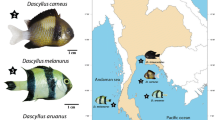Abstract
The study of chromosomes in insects is a good tool in mitotic process analysis, zoographic localization and evolution investigation. Among them, the Sciaridae offers a karyotype with a small number of chromosomes, where the heterochromatin and nucleolar organizer region, NOR, are easily analyzed in metaphase chromosomes obtained from cerebral ganglia squashes. In this work, the heterochromatic regions on Bradysia hygida mitotic chromosomes, revealed by C-banding, were identified as centromeric blocks on A and C chromosomes and as dark interstitial region in B and X chromosomes. By Ag-DAPI staining, active nucleolus organizer region, NOR, was revealed associated to the constitutive heterochromatin in the end of the C autosome chromosome. The C-band regions and the unusual ribosomal site localization are discussed.
Similar content being viewed by others
References
Amabis, J.M., 1983. The polytene chromosomes of the salivary gland of Trichosia pubescens (Diptera:Sciaridae). Rev. Bras. Genet. 3: 415–424.
Barzotti, R., F. Pelliccia & A. Rocchi, 1996. Heterochromatin and ribosomal genes in Asellus aquaticus (Crust.Isop.). Chrom. Res. 4: 177–181.
Bilinsiki, S.M. & B. Bilinska, 1996. A new version of the Ag-NOR technique. A combination with DAPI staining. Histoch. J. 28: 651–656.
Blackman, R.L. & J.M. Spence, 1996. Ribosomal DNA is frequently concentrated on only one X chromosome is permanently apomitic aphids, but this does not inhibit male determination. Chrom. Res. 4: 314–320.
Borges, A.R., V.P. Gaspar & M.A. Fernandez, 2000. Unequal X chromosomes in Bradysia hygida (Diptera:Sciaridae) females: karyotype assembly and morphometric analysis. Genetica 108: 101–105.
Canovai, R., B. Caterini, L. Contadini & L. Galleni, 1994. Karyology of the medfly Ceratitis capitata (Wied.) mitotic complement: ASG bands. Caryology 47: 241–247.
Clark, A.G., F.M. Szumski & E.M. Lyckegaard, 1990. Population genetics of the Y chromosome of Drosophila melanogaster: rDNA variation and phenotypic correlates. Genet. Res. Camb. 58: 7–13.
Crouse, H.V., S.A. Gerbi, C.M. Liang, L. Magnus & I.M. Mercer, 1977. Localization of ribosomal DNA withim the proximal X heterochromatin of Sciara coprophila (Diptera, Sciaridae). Chromosoma 64: 305–318.
da Conceição Silva, J.L. & M.A. Fernandez, 2000. Feulgen stain in heterogeneous egg samples from non-synchronized Bradysia hygida (Diptera:Sciaridae) laboratory culture. Cytologia 65: 167–171.
da Cunha, P.R., B. Granadino, A.L.P. Perondini & L. Sanchez, 1994. Dosage compensation in sciarids is achieved by hypertranscription of the single X chromosome in males. Genetics 138: 787–790.
de Saint-Phalle, B. & W. Sullivan, 1996. Incomplete sister cromatid separation is the mechanism of programmed chromosome elimination during early Sciara coprophila embryogenesis. Development 122: 3775–3784.
Eastman, E.M., R.M. Goodman, B.F. Erlanger & O.J. Miller, 1980. The organization of DNA in the mitotic and polytene chromosomes of Sciara coprophila. Chromosoma 79: 293–314.
Fontes, A.M., M.E. Conacci, N. Monesi, J.C. de Almeida & M.L. Paçó-Larson, 1999. The DNA puff BhB10-1 gene encodes a glycine-rich protein secreted by the late stage larval salivary glands of Bradysia hygida. Gene 29: 67–75.
Gatti, M. & S. Pimpinelli, 1992. Functional elements in Drosophila melanogaster heterochromatin. Annu. Rev. Genet. 26: 239–275.
Gatti, M. & M.L. Goldberg, 1991. Mutations affecting cell division in Drosophila, pp. 543–585 in Methods in Cell Biology, Vol. 35, edited by B.A. Hamkalo & S.C.R. Elgin. Academic Press, San Diego.
Gerbi, S.A., 1971. Localization and characterization of the ribosomal RNA cistrons in Sciara coprophila. J. Mol. Biol. 58: 499–511.
Gerbi, S.A., 1986. Unusual chromosomes movements in sciarids flies. Resufts Probl. Cell Differ. 13: 71–104.
Glover, D., 1990. Abbreviated and regulated cell cycles in Drosophila. Curr. Opin. Cell Biol. 2: 258–261.
Hales, D.F., 1989. The chromosomes of Schoutedenia lutea (Homoptera, Aphidoidea, Greenideinae), with an account of meiosis in the male. Chromosoma 98: 295–300.
Howell, W.M. & D.A. Black, 1980. Controlled silver-staining of organizer regions with a protective colloidal developer: a 1 step method. Experientia 36: 1014–1015.
Kumar, A. & K.S. Rai, 1990. Chromosomal localization and copy number of 18S+28S ribosomal RNA genes in evolutionarily diverse mosquitoes (Diptera, Culicidae). Hereditas 113: 277–289.
Laicine, E.M., M.A.R. Alves, J.C. de Aimeida, E. Rizzo, W.C. Albernaz & H. Sauaia, 1984. Development of DNA puffs a patterns of polypeptide synthesis in the salivary glands of Bradysia hygida. Chromosoma 89: 280–284.
Lakhotia, S.C. & M. Kumar, 1978. Heterochomatin in mitotic chromosomes of Drosophila nasuta. Cytobios 21: 78–89.
Lorite, P., E. Chica & T. Palomeque, 1996. Cytogenetic studies of ant Linepithema humile Shattuck (=Iridomyrmex humilis mayr) in European populations. Caryologia 49: 199–205.
Mesa, A., C.S. Fontaneffi & H. Costa, 1990. The karyotype of the grasshopper Spathalium helios Rehn 1918 (Orthoptera, Acridoidea, Ommmexechidae). Rev. Brasil. Genet. 13: 705–710.
Monesi, N., M.A. Fernandez, A.M. Fontes, L.R. Basso, J., Y. Nakanishi, B. Baron, G. Buttin & M.L. Paçó-Larson, 1995. Molecular characterization of an 18 kb segment of DNA puff C4 of Bradysia hygida (Diptera, Sciaridae). Chromosoma 103: 715–724.
Monteiro, S.G., R. Almeida, N.M. Diniz & F.M. Sene, 1994. Identification of the karyotype of Drosophila zotti: metaphase chromosomes. Rev. Brasil. Genet. 17: 339–340.
Pardue, M.L., S.A. Gerbi, R.A. Eckhardt & J.G. Gall, 1970. Cytological localization of DNA complementary to ribosomal RNA in polytene chromosomes of Diptera. Chromosoma 29: 268–290.
Polanco, C., A.I. Gonzalez, A. de La Fuente & G.A. Dover, 1998. Multigene family of ribosomal DNA in Drosophila melanogaster reveals contrasting patterns of homogenization for IGS and ITS spacer regions: a possible mechanism to resolve this paradox. Genetics 149: 243–256.
Riefell, S.M. & H.V. Crouse, 1966. The elimination and differentiation of chromosomes in the germ line of sciara. Chromosoma 19: 231–276.
Sanchez, L. & A.L.P. Perondini, 1999. Sex determination in sciarid flies: a model for the control of differential X-chromosome elimination. J. Theor. Biol. 197: 247–259.
Sauaia, H. & M.A.R. Alves, 1968. A description of a new species of Bradysia hygida. Papéis Avulsos de Zoologia 22: 85–88.
Zuckerlandl, E. & W. Hennig, 1995. Tracking heterochromatin. Chromosoma 104: 75–83.
Author information
Authors and Affiliations
Rights and permissions
About this article
Cite this article
Gaspar, V.P., Borges, A.R. & Fernandez, M.A. NOR Sites Detected by Ag-DAPI Staining of an Unusual Autosome Chromosome of Bradysia Hygida (Diptera:Sciaridae) Colocalize with C-banded Heterochromatic Region. Genetica 114, 57–61 (2002). https://doi.org/10.1023/A:1014698401988
Issue Date:
DOI: https://doi.org/10.1023/A:1014698401988




